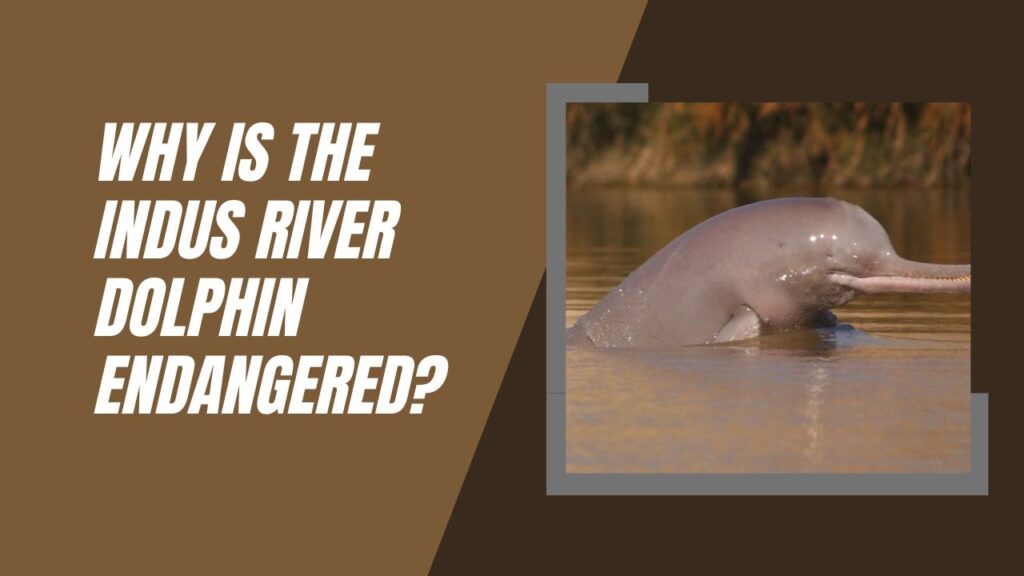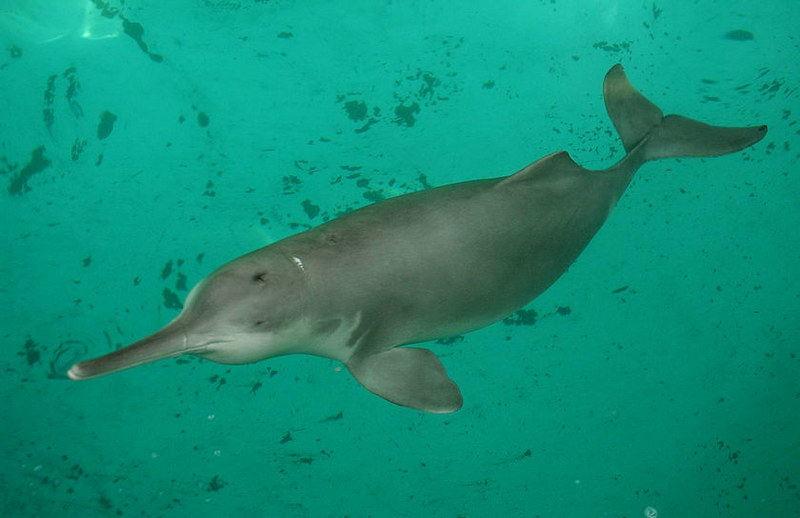Last updated on December 28th, 2023 at 04:06 pm

Why Is The Indus River Dolphin Endangered? The Indus River Dolphin is endangered due to habitat loss, pollution, and accidental entanglement in fishing gear. Their population has declined significantly over the years.
Since these dolphins only live in freshwater environments, they are especially susceptible to human activity.
Their habitat has been disrupted and degraded by widespread water pollution and the building of dams and barrages, which makes it harder for them to survive.
In addition, a major danger to their existence is inadvertent entrapment in fishing nets.
Indus River Dolphins are critically endangered due to their shockingly low population, and immediate conservation action is required to keep them alive.
Table of Contents
Understanding The Indus River Dolphin
Physical Characteristics
Platanista gangetica minor, the scientific name for the Indus River Dolphin, is a rare species of freshwater dolphin that lives only in Pakistan’s lower Indus River.
These dolphins can be identified by their distinct physical characteristics. One of their most useful adaptations for navigating the murky waters of their home is a long, narrow beak.
They differ from marine dolphins in that they have stocky bodies and no dorsal fin. They have tiny, hardly perceptible eyes and range in color from pale gray to pink.
Habitat And Distribution
The ability to survive of this endangered species is closely related to the habitat and distribution of the Indus River Dolphin.
These dolphins have developed special adaptations to survive in the murky, muddy waters of the Indus River. The main stem of the river, its tributaries, and a few nearby freshwater lakes are where they are mostly found.
Their range is now limited to a few spots inside the river as a result of numerous human activities. They are particularly susceptible to alterations in the environment and human intervention because of their restricted habitat. [Why Is The Indus River Dolphin Endangered?]
See Also: What Do River Dolphins Eat? How Do River Dolphins Find Food?
Threats To The Indus River Dolphin
Human Impact On The River Ecosystem
The Indus River Dolphin’s survival is seriously threatened by human activity’s effects on the river ecology.
The natural flow of the river has been disturbed by dams and irrigation projects, which has resulted in habitat fragmentation and a decrease in the supply of prey.
The water quality of the river is impacted by damming, which puts the dolphins in even more danger.
Pollution And Habitat Degradation
The dolphin species has suffered as a result of pollution and habitat loss in the Indus River.
The wellness of the dolphins and their prey has been impacted by pollution in the river caused by domestic garbage, agriculture, and industry.
The utilization of gillnets and unsafe techniques for fishing have furthermore added to the decrease of the Indus River Dolphin.
Conservation Efforts
Conserving the biodiversity of this endangered species depends critically on the conservation of the Indus River Dolphin.
The Indus River Dolphin is seriously threatened by anthropogenic influences, making it a vulnerable species.
Nonetheless, there is optimism for the future thanks to coordinated efforts and initiatives. Let’s examine the issues, plans for the future, and present conservation initiatives for the Indus River Dolphin. [Why Is The Indus River Dolphin Endangered?]
See Also: Where Are Pink Dolphins Found? Unraveling the Mystery
Current Initiatives And Organizations
Numerous governmental and non-governmental entities have assumed responsibility for spearheading conservation initiatives for the Indus River Dolphin.
The WWF-Pakistan has demonstrated notable leadership in executing conservation initiatives in partnership with indigenous people.
These programs include restoring habitat, monitoring the dolphin population through surveys, and spreading awareness of the value of conserving this species.
In addition, the Indus River Dolphin Conservation and Rehabilitation Center has played a significant role in the behavior research, rescue operations, and rehabilitation of stranded dolphins in preparation for their eventual release back into the wild.
These groups put in a lot of effort to lessen the risks that come from human activity and preserve the Indus River Dolphin’s natural environment. [Why Is The Indus River Dolphin Endangered?]
See Also: Can Dolphins Live In Brackish Water? The Ultimate Guide
Challenges And Future Strategies
The preservation of the Indus River Dolphin still faces formidable obstacles in spite of these determined efforts. The habitat loss of dolphins as a result of dam development and water pollution is one of the main challenges. The species’ survival is seriously threatened by this.
To guarantee the availability of pure and continuous river flow, which is necessary for the survival of the dolphin, future policies should concentrate on sustainable water management.
The establishment of sanctuaries and protected areas along the Indus River will give dolphins a safe sanctuary where they can flourish free from human influence.
Furthermore, the development and implementation of comprehensive conservation plans require cooperative efforts between local populations, governmental entities, and international conservation groups.
The future of the endangered Indus River Dolphin may be saved with the help of cooperative efforts and unwavering commitment.

Role Of Community Involvement
An important aspect of the fight for the conservation of the endangered Indus River Dolphin is community involvement.
A key element in guaranteeing the survival of this rare species is involving local populations and evaluating the effects of their involvement.
Here, we explore the importance of community involvement and its potential benefits for Indus River Dolphin conservation.
Engaging Local Communities
It is crucial to involve local populations in the conservation activities aimed at protecting the Indus River dolphin for multiple reasons.
Locals frequently possess in-depth knowledge of the environment of the river and all of its species, including the dolphins.
Their opinions can help with conservation efforts by offering insightful information about the habitats and behavior of these animals.
Involving the neighborhood communities also fosters a sense of accountability and ownership for safeguarding the dolphins and their habitat. This may result in a more inclusive and sustainable method of conservation. [Why Is The Indus River Dolphin Endangered?]
Impact Of Community Participation
The survival of the Indus River Dolphin may be significantly improved by community involvement in conservation efforts.
Conservationists can obtain more detailed and precise information on the dolphin population and the risks they face by including local communities in monitoring and data collection.
Community involvement can also result in the creation of environmentally friendly fishing methods and habitat preservation, both of which are essential for dolphin welfare.
Additionally, educating the community about the value of protecting the Indus River Dolphin can help build a network of support that will help keep the species alive for future generations.
Sustainable Solutions
To preserve the existence of this rare species, immediate action is required due to the Indus River Dolphin’s endangered status. In the battle to save these amazing animals, sustainable development strategies and the balancing of conservation efforts with socioeconomic demands are essential.
Putting Sustainable Development Principles Into Practice
Putting solutions that support long-term environmental and economic sustainability into practice is a necessary part of implementing sustainable development techniques.
This can be accomplished by taking steps like enacting sustainable fishing methods, encouraging eco-friendly agriculture, and controlling the disposal of industrial waste.
It is possible to prevent further degradation of the Indus River Dolphin’s habitat by ensuring sustainable resource utilization and limiting environmental degradation. [Why Is The Indus River Dolphin Endangered?]
Balancing Conservation Efforts With Socio-economic Needs
The Indus River Dolphin depends on balancing socioeconomic demands with conservation initiatives. It necessitates striking a careful balance between protecting natural areas and assisting local populations in their daily needs.
This can be achieved by starting ecotourism projects that are sustainable, giving river-dependent communities other sources of income, and encouraging locals to understand the advantages of environmental preservation.
Social and economic development can be integrated with conservation objectives to promote the welfare of dolphins and communities alike.
See Also: Can Dolphins Live In Lakes? A Fascinating Exploration
Frequently Asked Questions On Why Is The Indus River Dolphin Endangered?
Why Are River Dolphins Endangered?
Overfishing, pollution, and habitat degradation have put river dolphins in jeopardy. Their habitat is impacted by dam building and water pollution, and they run the risk of becoming mistakenly entangled in fishing gear. In order to safeguard these rare and endangered species, conservation activities are essential.
How Many Indus Dolphins Are Left?
There are approximately 2,000 Indus river dolphins left in the wild. These unique creatures are considered endangered.
Why Are Chinese River Dolphins Endangered?
The Chinese River dolphins are endangered due to habitat loss, pollution, and bycatch in fishing nets. These factors have led to a decline in their population, threatening their survival.
What Is The Really Endangered Dolphin?
The vaquita dolphin, which is found in the Gulf of California, is truly endangered species. The population is very reduced as a result of bycatch and unlawful fishing methods. To prevent the extinction of this species, urgent conservation actions are required.
In summary
The main causes of the Indus River dolphin’s endangered status are human activities such as building dams, pollution, and overfishing.
The protection of their habitat and population depends heavily on conservation initiatives.
Future generations’ access to this rare species can be ensured by applying sustainable practices, collaborating across national boundaries, and raising awareness.

Mr. Das, a certified pharmaceutical scientist, holds a Bachelor of Science in Pharmaceutical Sciences and passionately contributes to dolphin conservation as a member of the committee in Bangladesh.


